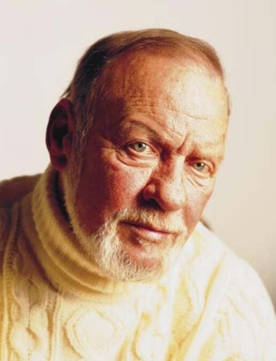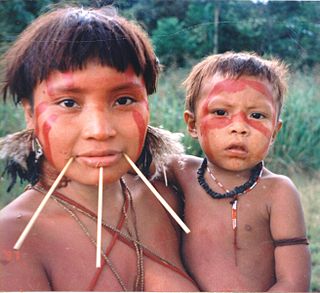Related Research Articles

Darkness in El Dorado: How Scientists and Journalists Devastated the Amazon is a polemical book written by author Patrick Tierney in 2000, in which the author accuses geneticist James Neel and anthropologist Napoleon Chagnon of conducting human research without regard for their subjects' well-being while conducting long-term ethnographic field work among the indigenous Yanomamo, in the Amazon basin between Venezuela and Brazil. He also wrote that the researchers had exacerbated a measles epidemic among the Native Americans, and that Jacques Lizot and Kenneth Good committed acts of sexual impropriety with Yanomamo.

Napoleon Alphonseau Chagnon was an American cultural anthropologist, professor of sociocultural anthropology at the University of Missouri in Columbia and member of the National Academy of Sciences. Chagnon was known for his long-term ethnographic field work among the Yanomamö, a society of indigenous tribal Amazonians, in which he used an evolutionary approach to understand social behavior in terms of genetic relatedness. His work centered on the analysis of violence among tribal peoples, and, using socio-biological analyses, he advanced the argument that violence among the Yanomami is fueled by an evolutionary process in which successful warriors have more offspring. His 1967 ethnography Yanomamö: The Fierce People became a bestseller and is frequently assigned in introductory anthropology courses.

Timothy Asch was an American anthropologist, photographer, and ethnographic filmmaker. Along with John Marshall and Robert Gardner, Asch played an important role in the development of visual anthropology. He is particularly known for his film The Ax Fight and his role with the USC Center for Visual Anthropology.
The Human Studies Film Archives (HSFA) is a sister archive to the National Anthropological Archives within the Smithsonian's National Museum of Natural History. HSFA preserves and provides access to ethnographic films and anthropological moving image materials. It is located at the Smithsonian Museum Support Center in Suitland, Maryland.
Patrick Tierney is an American writer based in Pittsburgh, Pennsylvania, who is the author of three books based on frequent visits to and field research in South America. As a mountain climber, he has worked with Johan Reinhard. He has made discoveries of Inca ceremonial mountaintop sites and, with Reinhard, made the second modern ascent of Mt. Del Veladero (21,115 ft) in Argentina in 1988. An Inca ceremonial platform and sacrificial site was discovered on top. Tierney has climbed all of the highest peaks in the Andes.

The Ax Fight (1975) is an ethnographic film by anthropologist and filmmaker Tim Asch and anthropologist Napoleon Chagnon about a conflict in a Yanomami village called Mishimishimabowei-teri, in southern Venezuela. It is best known as an iconic and idiosyncratic ethnographic film about the Yanomamo and is frequently shown in classroom settings.

Davi Kopenawa Yanomami, name also written Davi Kobenawä Yanomamö, is a Yanomami shaman and Portuguese-speaking spokesperson for the Yanomami People in Brazil. He became known for his advocacy regarding tribal issues and Amazon rainforest conservation when the tribal rights organization Survival International invited him to accept the Right Livelihood Award on its behalf in 1989. In 2019, Yanomami and the Hutukara Yanomami Association were also awarded the Right Livelihood Award. Yanomami spoke to both the British and Swedish parliaments about the catastrophic impact on Yanomami health as a consequence of the illegal invasion of their land by 40,000 ‘garimpeiros’ or goldminers. Prince Charles publicly called the situation ‘genocide’. In a seven-year period from 1987 to 1993 one fifth of the Yanomami died from malaria and other diseases transmitted by the miners.
Magical Death is a documentary film by anthropologist Napoleon Chagnon, that explores the role of the shaman within the Yanomamo culture, as well as the close relationship shamanism shares with politics within their society.
Dodoth Morning is a 1976 film by ethnographic filmmaker Tim Asch.

An ethnographic film is a non-fiction film, often similar to a documentary film, historically shot by Western filmmakers and dealing with non-Western people, and sometimes associated with anthropology. Definitions of the term are not definitive. Some academics claim it is more documentary, less anthropology, while others think it rests somewhere between the fields of anthropology and documentary films.
Duku kä misi is the topmost and oldest of four layers in the Ya̧nomamö cosmos. Everything in the cosmos originated in the duku kä misi, but it subsequently fell down into lower layers and duku kä misi has since been abandoned. The Ya̧nomamö compare it to an "old woman" and give it the characteristics of an "abandoned garden". In Ya̧nomamö culture gardens share with post-menopausal women lack of fertility. Of the four layers, it is the least referred to in Ya̧nomamö culture.
Hedu or Hedu kä misi is the Ya̧nomamö heaven and in the Ya̧nomamö cosmos the second highest of four layers. The top face of Hedu is like the earth in all ways, containing wildlife, plants and gardens, but instead of living humans the Ya̧nomamö believe it to be the residence of the dead. The activities of humans in Hedu, like the environment there, resembles life on earth in most respects, and the dead eat, hunt, copulate and practice witchcraft, just as living people do.
In the Ya̧nomamö cosmos, '''Hei kä misi''' is earth and the third highest of four vertically parallel layers. The Ya̧nomamö believe that Hei kä misi was created when a part of Hedu kä misi (Heaven) got dislodged and fell.
Hei tä bebi is the lowest of the four layers in the Ya̧nomamö cosmos. According to Ya̧nomamö tradition, hei tä bebi was created after a piece of hedu kä misi (heaven) fell onto Hei kä misi (earth). The falling piece of hedu knocked a hole into hei kä misi, creating a hole and dislodging a swathe of earth which fell below forming hei tä bebi.
Ama̧hiri-teri is the village and people of Ya̧nomamö mythology thought to inhabit the desolate underworld, Hei tä bebi. According to Ya̧nomamö folklore they had originally inhabited the earth, Hei kä misi, but when a piece of Hedu kä misi (heaven) fell down it fell onto Ama̧hiri-teri, creating a hole and carrying the village and people through. As the only physical environment carried through was the Ama̧hiri-teri shabono (village) and gardens, the landscape is void of significant natural resources, forcing the Ama̧hiri-teri to turn to cannibalism.

The Yanomami, also spelled Yąnomamö or Yanomama, are a group of approximately 35,000 indigenous people who live in some 200–250 villages in the Amazon rainforest on the border between Venezuela and Brazil.

The Yanomami people are an indigenous group who live in the Amazon Rainforest along the borders of Venezuela and Brazil. There are estimated to be only approximately 35,000 indigenous people remaining. They are interfluvial Indians who live in small villages along the Mavaca and Orinoco Rivers, with each village consisting of a single shabono, or communal dwelling. Largely uncontacted by the outside world, the Yanomami have been affected by illnesses introduced by gold miners since the 1980s. Anthropological studies have emphasized that the Yanomami are a violent people, and although this can be true, the women of the Yanomami culture generally abstain from violence and warfare. Although males dominate the Yanomami culture, Yanomami women play an important role in sustaining their lifestyle.
Kenneth Good is an anthropologist most noted for his work among the Yanomami and his account of his experiences with them: Into the Heart: One Man’s Pursuit of Love and Knowledge Among the Yanomami. While researching and living with the group in Venezuela, Good married a Yanomami woman named Yarima, who emigrated to the United States with Good when he returned home. Their three children were raised in the United States, but Yarima, finding adapting to life in the United States too difficult, returned to her village when the children were young.

Yanomamö: The Fierce People is a 1968 book by American cultural anthropologist Napoleon Chagnon. It is an ethnographic study of the Yanomami people of the Amazon.
References
- "Tim Asch & Napoleon Chagnon: A Man Called "Bee": Studying the Yanomamo". www.der.org. Archived from the original on 3 February 2007. Retrieved 15 February 2007.